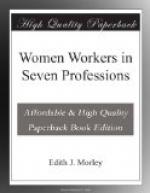There seems some ground for believing that official opinion in this matter is undergoing modification, since in the case of later appointments—e.g., in the Labour Exchanges and in the National Health Insurance Commission—the tendency has been to approximate the salaries of women much more closely to those of men and even in some instances to make them identical. It is therefore reasonable to hope that the principle of equal pay for equal work will, before long, be extended to appointments of longer standing, in which its application would be no less just than in the case of new appointments.
II
THE LOWER GRADES AND THE PRESENT POSITION
So far as the position of its women workers is concerned, the State is very far from being the model employer it sometimes professes to be. When one considers the very wide disparity existing between the salaries for similar work of women and of men, one realises to what an enormous extent the Exchequer, and, consequently, the taxpayer, has benefited by the economies practised at the expense of the women Civil Servants ever since their introduction in the early seventies. There is not a shadow of doubt that economy was the motive for their employment, but even economy would not have justified the continued increase in their numbers, had they not exhibited what has been called by a high official, “remarkable efficiency,” and also the very desirable qualities of docility, patience, and conscientiousness.
When the Government first took over the telegraphs from the private companies, it found women in their employ, and decided to retain them in the service. Women Telegraphists and Counter Clerks are now a very large body numbering in London about 2,000, and in the Provinces about 5,000,—a total of 7,000 women as compared with 16,000 men. The duties of men and women telegraphists are more closely comparable than their respective work in any other class in the Civil Service, practically the only differentiation being that women are debarred from night duty. They are also generally exempt from Sunday duty, excessive late duty, and special duties in connection with race meetings, although the Hobhouse Committee in 1907 recommended that women should do the Sunday work if required. (As, however, payment for this is made at a higher rate, there is usually no lack of volunteers.) Their scale of salary in the Central Telegraph Office is 18s. a week at eighteen years of age, rising to a maximum of 40s. The men’s scale is 20s. rising to 65s. When the necessary technical qualifications are acquired, an allowance of 3s. a week carried beyond the maximum and pensionable, is now given to both sexes alike. Formerly the technical allowance for women was 1s. 6d. per week only, and this would appear to account for the lower proportion of women who have qualified for the technical increment.




